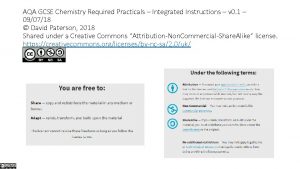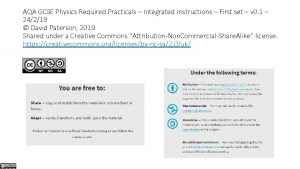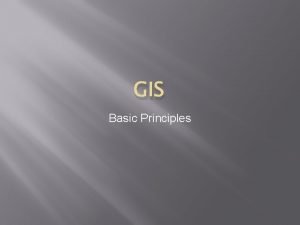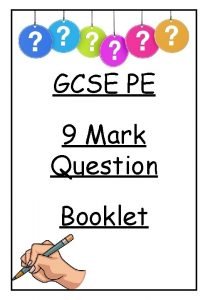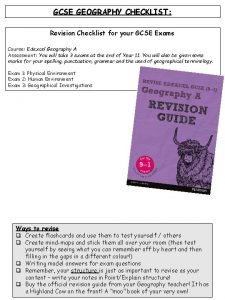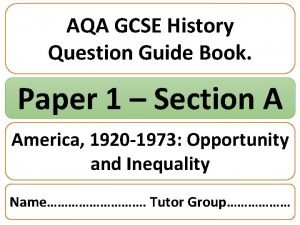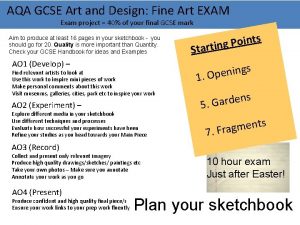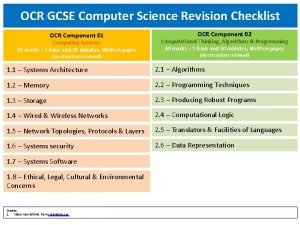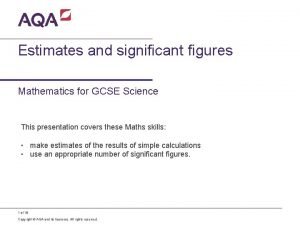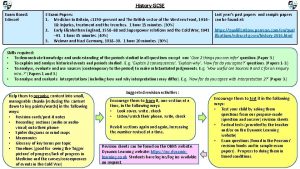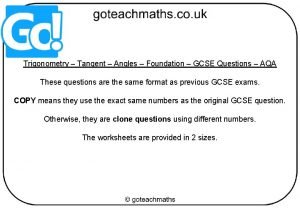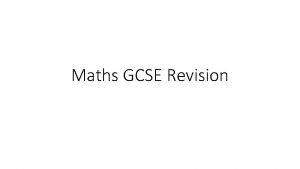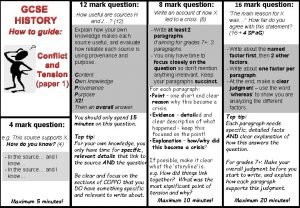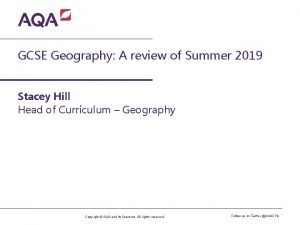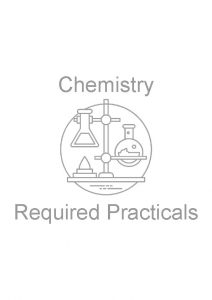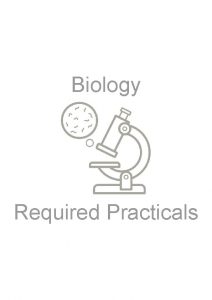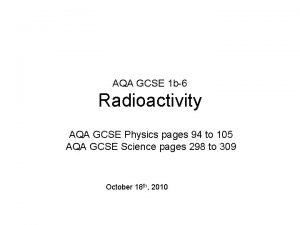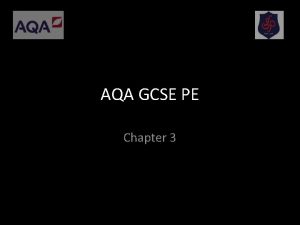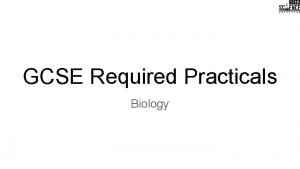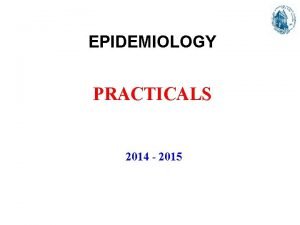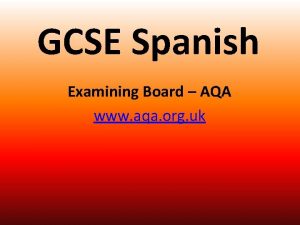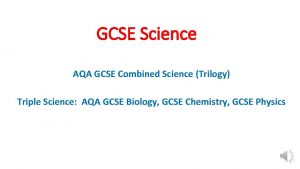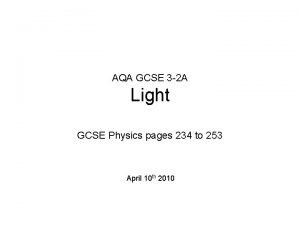AQA GCSE Chemistry Required Practicals Integrated Instructions v














- Slides: 14

AQA GCSE Chemistry Required Practicals – Integrated Instructions – v 0. 1 – 09/07/18 © David Paterson, 2018 Shared under a Creative Commons “Attribution-Non. Commercial-Share. Alike” license. https: //creativecommons. org/licenses/by-nc-sa/2. 0/uk/

Filter copper 1. 8 -2. 0 g copper oxide. Add half and swirl, wait 1 minute, add the other half. 15 cm 3 sulfate solution (max 3 min) sulfuric acid – wait 2 minutes Half fill with just boiled water xxxxxxxxxxx Pour filtered GCSE Chemistry: Making salts Designed in line with practicals in AQA GCSE Chemistry / Combined Science Handbooks http: //www. aqa. org. uk/resources/science/gcse/teach/practicals using http: //science. cleapss. org. uk/Resource/PP 027 -Making-copper-sulfatecrystals. pdf Remove funnel, then gently heat solution (half-blue) for 3 minutes – DO NOT BOIL heated copper sulfate into the evaporating dish; observe for 5 minutes

25. 0 cm 3 Na. OH (pipette) Fill to 0. 0 cm with H 2 SO 4 5 -10 drops of indicator 3 Measure and record volume Add H SO and …. 2 Tap is closed 4 … swirl GCSE Chemistry: Neutralisation Designed in line with practicals in AQA GCSE Chemistry / Combined Science Handbooks http: //www. aqa. org. uk/resources/ science/gcse/teach/practicals until colour change

50. 0 cm 3 electrolyte solution Electrodes Petri dish lid 4 V Power pack 5 minutes 00. 00 Damp blue litmus paper gas test Observe GCSE Chemistry: Neutralisation Designed in line with practicals in AQA GCSE Chemistry / Combined Science Handbooks http: //www. aqa. org. uk/resources/ science/gcse/teach/practicals negative electrode and record Observe positive electrode and record

Stir until temperature stops changing – record temperature 5 cm 3 acid (measuring cylinder) GCSE Chemistry: Temperature Designed in line with practicals in AQA GCSE Chemistry / Combined Science Handbooks http: //www. aqa. org. uk/resources/ science/gcse/teach/practicals alkali Repeat Step 30 cm 3 Repeat until a total of 40 cm 3 alkali is added

Swirl flask Place on cross Start timer Stop timer when cross has disappeared – record time Add GCSE Chemistry: Rates of reaction 1 Designed in line with practicals in AQA GCSE Chemistry / Combined Science Handbooks http: //www. aqa. org. uk/resources/sci ence/gcse/teach/practicals 10 cm 3 20 cm 3 30 cm 3 40 cm 3 50 cm 3 sodium thiosulfate (measuring cylinder) 00. 00 Add 10 cm 3 10 cm 3 acid (measuring cylinder) Add 40 cm 3 30 cm 3 20 cm 3 10 cm 3 no cm 3 water (measuring cylinder)

Set up gas collection apparatus QUICKLY place bung into conical flask AND start the timer 00. 00 50 cm 3 record volume every 10 s, for 100 s. 2. 0 M acid 00. 00 3 cm magnesium ribbon Measure and GCSE Chemistry: Rates of reaction 2 Designed in line with practicals in AQA GCSE Chemistry / Combined Science Handbooks http: //www. aqa. org. uk/resources/sc ience/gcse/teach/practicals

Label the spots Spot each food colouring in turn: A B C D U Place chromatogram in beaker Roll paper round glass rod and tape Draw base line in pencil GCSE Chemistry: Chromatography Designed in line with practicals in AQA GCSE Chemistry / Combined Science Handbooks http: //www. aqa. org. uk/resources/ science/gcse/teach/practicals Add water into beaker Remove chromatogram and draw the solvent front in pencil

Dip loop in metal chloride solution GCSE Chemistry: Identifying ions 1 Designed in line with practicals in AQA GCSE Chemistry / Combined Science Handbooks http: //www. aqa. org. uk/resources/ science/gcse/teach/practicals Flame loop and observe colour Clean the loop

Separately 1 cm 3 CARBONATE TEST: If each sodium salt solution Add 1 cm 3 HCl GCSE Chemistry: Identifying ions 2 Designed in line with practicals in AQA GCSE Chemistry / Combined Science Handbooks http: //www. aqa. org. uk/resources/ science/gcse/teach/practicals bubbles, limewater test SULFATE TEST: HALIDE TEST: • 3 drops nitric acid • 1 cm 3 barium chloride • 3 drops nitric acid • 1 cm 3 silver nitrate

Attach delivery Clamp flask tube Ice water Anti-bumping granules xxxxxxxxxxx 40 cm 3 ‘sea water’ GCSE Chemistry: Water purification 1 Designed in line with practicals in AQA GCSE Chemistry / Combined Science Handbooks http: //www. aqa. org. uk/resources/scienc e/gcse/teach/practicals Heat until 5 cm 3 distilled water collected

1 cm sample 3 water 3 -4 drops universal indicator Observe and record colour GCSE Chemistry: Water purification 2 Designed in line with practicals in AQA GCSE Chemistry / Combined Science Handbooks http: //www. aqa. org. uk/resources/scie nce/gcse/teach/practicals Weigh empty evaporating dish and record 4 cm 3 3. 45 g water sample Use water bath to evaporate water sample xxxxxxxxxxx Remove evaporating dish (TONGS), dry base and weigh and record 3. 78 g Repeat for each water sample

1. 8 -2. 0 g copper oxide. Add half and swirl, wait 1 minute, add the other half. xxxxxxxxxxx 82. 3 g 00. 00

 Aqa chemistry required practicals
Aqa chemistry required practicals Physics required practicals
Physics required practicals Tweetmap
Tweetmap Gcse pe 9 marker
Gcse pe 9 marker Edexcel geography gcse checklist
Edexcel geography gcse checklist Gcse history paper 1
Gcse history paper 1 Art gcse aqa
Art gcse aqa Religious studies gcse aqa past papers
Religious studies gcse aqa past papers Aqa gcse maths revision checklist
Aqa gcse maths revision checklist Aqa gcse physics
Aqa gcse physics Re gcse past papers edexcel
Re gcse past papers edexcel Gcse angles questions
Gcse angles questions Aqa maths gcse revision guide
Aqa maths gcse revision guide How to answer a 12 mark question in history
How to answer a 12 mark question in history Kendal industrial park aqa
Kendal industrial park aqa
